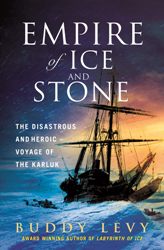 Pirates and Privateers Pirates and Privateers
The History of Maritime
Piracy
Cindy Vallar, Editor
& Reviewer
P.O. Box 425,
Keller, TX 76244-0425
    
Books for
Adults ~ Exploration & Travel

Empire of Ice and Stone: The Disastrous and Heroic
Voyage of the Karluk
By Buddy Levy
St. Martin’s, 2022, ISBN 978-1-250-27444-1, US $29.99
/ CAN $39.99
Also available in e-book format
    
When Vihjalmur
Stefansson stepped off the boat in Seattle
in September 1912, he already had a plan.
He had spent the past four years exploring
the Arctic coast of North America and
already wanted to return. This time, he
intended to take with him more scientists
than had ever studied the Arctic before.
They would explore new lands, perhaps even
confirm the existence of the lost tribe of
Blond Eskimos that was capturing the
public’s imagination. He possessed the
necessary charisma and persuasiveness to
achieve his goal. When the unexpected
happened, he could promptly adjust to fit
the new circumstances. Traits essential
for this new journey. But he also had less
admirable qualities. He could deceive and
manipulate to accomplish what he wanted,
for his own gain, regardless of the impact
doing so had on others.
With the sea in his blood, Robert Bartlett
had a goal: to become a master mariner.
His uncle was captain of Robert Peary’s
flagship on his first expedition to the
North Pole. Would Robert like to join
them? The answer, of course, was yes, and
this voyage was but the first of three
that he made. By the time he departed with
Peary on the third venture in 1908, he had
achieved his goal of becoming a master
mariner, captained Peary’s ship, navigated
for the explorer on sea and ice, and was
his trusted confidant. His experiences had
taught him how to survive the harsh,
unforgiving environment. When Steffanson’s
telegram arrived in May 1913, asking him
to captain the Karluk, Bartlett
was up for the challenge.
His first sight of the Karluk did
not instill Bartlett with confidence. She
was a steam brigantine of 247 tons and 129
feet. She had made fourteen trips in
Arctic waters during the twenty-eight
years since her launch, and her condition
showed each one of them. Stefansson had
purchased her for $10,000; Bartlett
insisted she be completely overhauled,
which cost an additional $6,000. The bill
would be paid by the government of Canada,
which was backing the expedition. The
problem was that time was not on his side,
and by the time he could hire a crew, the
best mariners had already departed and he
had to settle for what he could find
rather than handpicking the best.
Fourteen esteemed scientists from
different parts of the world joined the
expedition, but only two had ventured into
the polar region before. What a couple
lacked in age and experience, they made up
for with determination and passion. Native
hunters would provide food, guidance, and
shelter while a Native seamstress joined
to make suitable Arctic weather gear from
the hides brought down by the hunters.
Stefansson wanted to sail as far north as
possible. If the ice pack surrounded the Karluk,
preventing her from going anywhere, she
would become their base camp and they
would venture afield on foot and with dog
sleds. When they finally embarked, it
didn’t take long for problems to surface.
By August third, Karluk was
surrounded by ice, drifting instead of
going where the captain wanted. The mix of
university graduates, crew members, and
indigenous people created tension and
division. And then Stefansson, his
secretary, two hunters, a photographer,
and an anthropologist left the ship on a
badly planned hunting trip, leaving
Bartlett in charge of twenty-two men, one
woman, two small children, twenty-two sled
dogs, and one kitten. Each day, the ice
grew thicker and closer, and Bartlett knew
it had the power to crush and sink Karluk.
If that happened, no one back home knew
where they were and they might never be
found.
This riveting account is one of
perseverance and hope, tragedy and loss.
Levy vividly transports us back in time to
a place few of us have ever or will every
journey, yet the frigid cold permeates our
body, the beauty awes our spirit, and the
consternation disturbs our soul. The
inclusion of snippets from logs and
journals makes the journey that these
people endured more personal and evokes an
array of emotions in us. To further
enhance the experience he includes maps, a
list of who’s who, a time line of arctic
exploration, expeditions, and disasters
from 982 to 1913, a bibliography, and an
index. Not only are we introduced to those
who participated in this journey, but the
inclusion of photographs from it allows us
to meet each person and to glimpse what
they saw. To round out the voyage, Levy
also shares what became of the survivors.
Their harrowing ordeal “three hundred
miles north of the Arctic Circle,” as well
as two members’ trek to Siberia to save
their comrades, haunts us long after this
journey ends. (184)
Review Copyright ©2023 Cindy Vallar

Click to contact me
Background image compliments
of Anke's Graphics |

